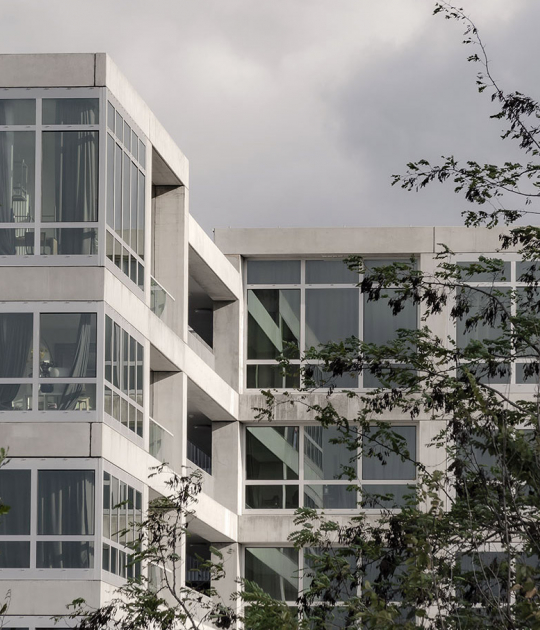Materiality will be another very important aspect in the project, in the balconies the use of wood in the coating of the floors in front of the glass enclosure in the balcony railings as the white coating forge a feeling of elegance at the same time it seeks to be a warm and pleasant space.
The houses follow a very defined program for a type of resident determined according to the type to better suit their own needs, each having different partitions and elements that make them unique, moving away from the repetitive model of a conventional block of houses.
Description of project by Parc Architects
Form Allows Actions
Resilience consists of adapting to shocks or "traumatic" changes, it translates into architecture with the ability to maintain, adapt, transform and rehabilitate. These ideas are incorporated into the fundamental elements of the design. From a pragmatic point of view, It is about considering all the possible arrangements that architectural space could have. We thus update Louis Sullivan's formula: Form Allows Actions.
Located in the Island of Nantes, Form Allows Actions, as well as the bunker adjoining, is a concrete structure, rough and durable. The project fits into its site. It presents very regular facades on the streets, echoing the rhythm and format of the openings of the neighboring 19th century building.
On the open landscape side, wide curved balconies open out into space on the large shipyard square. Designed as additional rooms to live in, they allow inhabitants to exchange ideas, creating bonds between neighbors.
The building materials are simple and assert their character. The body of the building is in stained concrete, the balconies are wooden-cladded, the railings are in glass and the roof in zinc. The sculptural forms of concrete are offered for the free appropriation of the inhabitants.
Socially resilient, the project places the inhabitant and their future at the center of the design. By combining stability and flexibility.
The positioning of the openings and the width of the piers has been developed to allow an infinite number of compartments. The technical ducts have been designed so that the bathrooms can be transformed according to use. Like the buildings of the 18th and 19th century, the architectural arrangements allow scalability, making it possible to move from large to small housing or even to partial office use.
This project supports the idea that resilience, like living together, comes through simplicity and not by adding more technology because we believe that we must do less to do better.
Observation.-
Collective housing produced in France is generic. It is often too small and rigid. It results from habit and standards that it is a question of updating to today's lifestyles. Concretely, in a lifetime, we are more likely to have to manage a separation and a stepfamily than to become severely disabled. It is also for new life paths that we must think of adaptable housing. Today, we must offer adaptable housing for each family, easily transformable and efficient. Evolving housing allows each of the inhabitants to project themselves into their current life, their future life and the life of their successors.
Our proposal aims to develop the current housing standard to give it potential for development. By respecting the usual surfaces and keeping reduced budget, we are reorganizing the accommodation to adapt it to current lifestyles.
The apartments are organized on a Parents / Children principle instead of the usual Day / Night division. Form Allows Actions places the living room in a central position and allows the rooms to be distributed on either side. Then, the bathrooms are installed at both ends of the accommodation. Finally, the entrance hall is positioned so that the apartment can be separated in two. You can thus change your apartment, using a few doors and partitions, as family life evolves to accommodate a young adult, a liberal activity such as a roommate.





























































